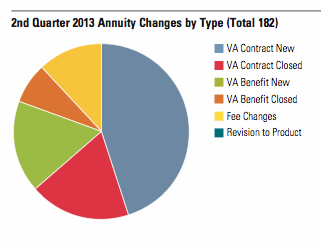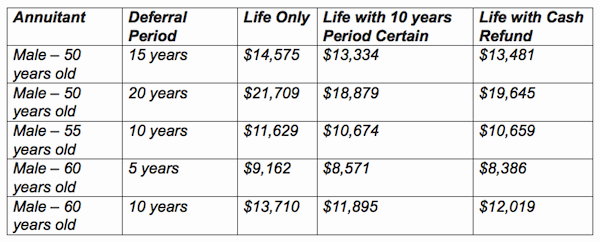
Denmark is Earth’s happiest country, at least according to a 60 Minutes broadcast from a few years ago. And the Danish pension system was not merely ranked first in the world in 2012, it was also the first and only system ever to achieve an A rating on the Melbourne Mercer Global Pension Index.
So when an actuary from that harmonious peninsula in the North Sea—a former chief actuary of that country, no less—claims to know a better way to optimize risk and reward during both accumulation and decumulation, well, attention must be paid.
For the past several weeks, Per Linnemann (right), who has also been an academic and long-time product developer at SEB Pension in Copenhagen, has been helping me understand how that company’s retirement savings mousetrap—called TimePension—resolves the conflicting needs for safety and upside in retirement. This mousetrap, by the way, won Insurance Risk magazine’s Innovation of the Year Award in 2009.
 TimePension’s beauty part, he explained, is that it cures the target-fund glidepath dilemma by allowing investors—either individuals or plan participants—to maintain a 60% equity allocation both before and after they retire. It manages downside risk with a “formula-based smoothing account,” ultimately backed by an insurance company. It delivers retirement income via a period certain smoothed income annuity coupled (optionally) with longevity insurance.
TimePension’s beauty part, he explained, is that it cures the target-fund glidepath dilemma by allowing investors—either individuals or plan participants—to maintain a 60% equity allocation both before and after they retire. It manages downside risk with a “formula-based smoothing account,” ultimately backed by an insurance company. It delivers retirement income via a period certain smoothed income annuity coupled (optionally) with longevity insurance.
Whether TimePension could work in the U.S. is debatable; in Denmark, even defined contribution money is centrally managed by professionals. Lump-sum cash-outs are the exception rather than the rule. But TimePension is not so fundamentally different from what AllianceBernstein, BlackRock, Prudential or Financial Engines are doing in the U.S. DC market. Asset managers who want to retain retirement plan assets during the transition from employment to retirement might find it especially appealing.
Linnemann, who has spent a lifetime working on pensions in industry, academia and government, is now, at age 60, a consultant. The number one item on his personal pre-retirement “bucket list” is to find an insurance company, asset manager or university in the U.S. that will provide a platform for adapting and developing smoothed income and lump sum products to the U.S. retirement market. [See Linnemann’s guest column in today’s RIJ]
“In 1952, TIAA-CREF created the variable income annuity. This innovation is intended to complete that product by offering greater stability in the pension payments,” he said. “That’s how I think of it.”
How TimePension works
For an explanation of how TimePension works at SEB Pension, Linnemann referred me to Frank Pedersen, a fellow actuary and childhood friend (a not unusual coincidence in Denmark) who is the company’s resident expert on the topic. He provided an example, based on a hypothetical plan participant making a 15%-of-pay contribution to a TimePension account. Here’s how it operates during the accumulation period.
Every month, 15% of each participant’s compensation goes into the pension account, which for convenience Pederson called Account #1, and all of the earnings from that account go into the smoothing or buffer account, which he called Account #2. Every month a small percentage of Account #2 accrues to Account #1. Most of the earnings stay in the buffer account as a reserve against potential losses.
“For example, if you put 100 kroner into Account #1 and the rate of return is 10%, so you have 10 kroner in Account#2, for a total of 110 kroner. This year, you would move one percent of Account#1, or one krone, from Account #2 to Account #1. That leaves 9 kroner in Account#2. Then you would take 20% of Account #2, or 1.8 kroner, and put it in Account #1. You still have 110 kroner in total, but you have 102.8 in your pension account and 7.2 in your smoothing account,” Pederson told RIJ.
“You would do the same thing if the rate of return had been minus 10%. You would move one krone to Account #1 from Account #2, which would now be minus 11. Then you would take 20% of that, or 2.2 kroner, and move that from Account #1 to Account #2. You would have 98.8 kroner in Account #1 and minus 8.8 kroner in Account #2. This is how the interest is divided.
“It becomes very stable over time. Every month, an amount equal to one-twelfth of one percent of Account #1 and one-twelfth of 20% of Account #2 moving to Account #1 from Account #2. This year the guaranteed accrual rate is only one percent, but in a normal year it’s about 3%,” he said.
TimePension has been running at SEB Pension for 10 years, and all but a few of the participants have seen positive returns in their primary accounts every year, including 2008, Pedersen said. In 2008, the overall fund lost 24.9%, but because Account #2 had an existing positive balance, and because Account #1 earned a guaranteed rate of 4.0% that year, and because the loss incurred by the overall fund was so diluted by the smoothing formula, there was no overall loss to the participants’ Account #1, even in the worst year of the financial crisis. “The following year we had a positive return of 17.5%, so all of the problem in Account #2 was gone,” he said.
The decumulation phase
When a TimePension participant retires, he or she decides whether to receive the balance as a smoothed income annuity over a period certain of between 10 and 25 years. The amount of the initial payment, like the initial payment of a variable income annuity in the U.S., is based on the principal accumulated in Account #1, the length of the term and an “assumed interest rate,” currently 3.5%. The monthly payments are smoothed up or down, depending on whether actual returns are higher or lower than 3.5%. The money remains invested in about 60% equities and 40% bonds, and the two accounts and the smoothing formula remain operative.
Here’s where SEB Pension’s insurance unit comes into play. During decumulation, the insurer provides some downside protection and participates in risk sharing in return. According to Pedersen, if he receives an amount equal to x% of his pension account (Account #1) in a given year, then SEB Pension will receive an amount equal to x% of his buffer account (Account #2) in that year, so long as the buffer account is positive. If Account #2 drops into negative territory, however, the insurance company must make a contribution of x% of Account #2. “We share the risk when it goes up and when it goes down,” he said.
There’s also a ratchet function available in TimePension that protects the participant and that may require a hedging program by the insurer. But the hedging is “plain vanilla,” Linnemann told Insurance Risk magazine in 2009, because the smoothing account itself absorbs most of the volatility.
What’s the point of all this backing and filling? According to one of Linnemann’s academic papers on the subject, the TimePension system produces higher returns on average than either of the other two retirement plan designs in Denmark, “unit-link” (like our 401(k) plans) and “traditional with-profits” (similar to TIAA-CREF’s retirement annuity fund). TimePension entails less volatility and less sequence of returns risk at retirement than unit-link plans, and its accrual method is more transparent than that of with-profits plans, while offering higher returns.
SEB Pension tried to patent TimePension back in 2002, but “because it was ‘formula-based’ we were told it wasn’t patentable,” Pedersen said. Given the novelty of TimePension, prospective enrollees and clients sometimes have difficulty grasping it. “Our biggest problem is to explain how it functions,” he conceded. “But if we have the opportunity to tell people how it functions, they’re receptive. Everyone knows that unit-linked is too risky. And they don’t like the traditional plan. Only a few people know about this new alternative.”
Business is growing, however. In the first six months of 2013, TimePension account for about 25% of SEB Pension’s sales. (SEB Pension has about 10% of Denmark’s pension market.) It is available as an individual as well as a group product. TimePension has caught the eye of the Britain’s Department for Work and Pensions, which has become interested in finding a DC/DB hybrid that involves greater risk-sharing between plan sponsors and plan providers. In Britain, this hypothetical hybrid has been dubbed “Defined Ambition.”
Taking it on the road
Could TimePension work in the U.S., as a retail product or as an institutional product? Given the differences between the U.S. and Danish tax systems and labor laws, the answer would appear to be no. For better or worse, Americans demand a lot more liquidity and flexibility with their retirement savings than Danes do. Danes can cash out of their TimePension plans, but they apparently have to absorb a prohibitive market value-adjustment and tax payment if they do.
None of the U.S. pension experts I spoke to were familiar with TimePension. The reactions of some retirement experts, after they were sent copies of one of Linnemann’s research papers, ranged from recognition to skepticism about the illiquidity of TimePension, to dismissal of any program that purports to cheat the laws of risk and reward.
Jeff Dellinger, a consultant who helped create Lincoln Financial’s i4Life variable income annuity and the author of The Handbook of Variable Income Annuities (Wiley, 2006), saw something familiar in TimePension. “It made me think of an arrangement I talked about in my VIA book for coping with volatility,” he said in an email.
“[The book explains that] there will be some natural ups and downs in monthly income from market movement. A region is defined where if the naturally calculated VIA payment would fall in that region, then nothing else happens. If the naturally calculated VIA payment would fall below or above that region, then only the floor or ceiling payment is made and the shortfall or excess adjusts the underlying reserve. This allows for volatility control in a less expensive way than simply having the insurance company trade the appropriate derivatives and pass their cost along to annuitants in the way of lower income.”
Mark Warshawsky, author of Retirement Income: Risks and Strategies (MIT, 2011) told RIJ, “It would appear that the [product] is not entirely liquid, and while in the Europe that may not be a big deal, in the US it probably is, in a negative way. For example, TIAA-CREF offers a smoothed interest rate and dividends on its TIAA accumulation and annuity products, with perhaps a higher expected return, but the lack of liquidity is always subject to complaint.”
The program director at the Center for Retirement Research at Boston College, Steve Sass, said, “The objective is important: to reduce the risk in 401(k)-type plans without resorting to expensive guarantees. And it does so by sharing risk, not by guaranteeing returns or pensions. While risk capacity is clearly different at different stages of life, and is lowest in retirement, and this could be a complicating factor, I’m willing to accept the simplification until it could be analyzed more carefully.”
Moshe Milevsky, the annuity expert at York University, was skeptical. “Repeat after me: No arbitrage, no free lunches, and risk can’t go away by ‘smoothing,’” he commented in an email.
But Linnemann points out that the centrally managed funds in a TimePension plan aren’t very different from the life-cycle or target-date funds that have become nearly ubiquitous in the U.S. defined contribution landscape.
Target-date funds have also been paired with guaranteed income solutions in DC plans by AllianceBernstein (Lifetime Income Strategy), which was adopted in 2012 by United Technologies, by Prudential Retirement (IncomeFlex), which adds a living benefit rider to TDFs and by Financial Engines, whose Income+ program manages both the accumulation and payout stages for participants, and offers an option for longevity insurance.
If these programs become more widely adopted—they’ve been stalled by fiduciary and liability concerns on the part of DC plan sponsors—it’s not impossible to see TimePension, with its unusual buffer account, added to the mix.
“In the U.S., defined contribution has moved into lifecycle products. But that is not enough. You need a product design like TimePension to get the best of both worlds. It’s not a money machine. You could still end up in a Japanese scenario with no returns for decades. But it would make the transition easier and you would gradually end up with a new level of return.”
Linnemann hopes to cap a 35-year actuarial career by spreading awareness of the TimePension concept, if not the exact product, around the world. “It’s been used by corporations and households in Denmark since 2002, and it’s not known internationally. Why should we wait a decade or more for it to spread by itself? Before I retire I would like to finish off my working period by developing this product class further.”
Linnemann would like to consult for an adventurous plan sponsor, like a Microsoft or Apple, who could eventually adopt a program like TimePension, or find an insurance company, asset manager or university who could provide a platform for further work.
“You could design different versions of this design for different companies, and a large company could have a say in what type of investment products are used. I’m hoping that many millions of people could have the benefit of more stable retirement income. As far as I have been able to see, there’s nothing that is as good as this.”
© 2013 RIJ Publishing LLC. All rights reserved.




 The most common changes were consolidations of age bands on the lifetime withdrawal benefit. The most significant changes were those related to de-risking by carriers—namely the asset reallocation directed to clients by Hartford, and the announced living benefit buyback offer by AXA (quarter 3 impact). Hartford also closed a number of contracts, further solidifying their pullout of the VA market.
The most common changes were consolidations of age bands on the lifetime withdrawal benefit. The most significant changes were those related to de-risking by carriers—namely the asset reallocation directed to clients by Hartford, and the announced living benefit buyback offer by AXA (quarter 3 impact). Hartford also closed a number of contracts, further solidifying their pullout of the VA market. Nationwide issued the Destination Architect 2.0, and I-share costing 0.40%. There are 110 subaccount options including a number of alternative asset classes. The contract carries a lifetime GMWB costing 0.80% that offers a 4.5% lifetime withdrawal guarantee (which moves to 5.0% after the 5th anniversary). The joint version offers 4.25% lifetime at age 65 for a 0.95% fee. It has a highest anniversary value step up.
Nationwide issued the Destination Architect 2.0, and I-share costing 0.40%. There are 110 subaccount options including a number of alternative asset classes. The contract carries a lifetime GMWB costing 0.80% that offers a 4.5% lifetime withdrawal guarantee (which moves to 5.0% after the 5th anniversary). The joint version offers 4.25% lifetime at age 65 for a 0.95% fee. It has a highest anniversary value step up.

 Who my clients are: I have one client. My glide path design is being used in a collective trust in Houston called the SMART Funds. It’s $50 million in all, used by 10 small plans. I’ve been trying hard to get the word out but I’m the world’s worst marketer. I’m working to get more investors in the SMART Funds. The funds are divided into three phases: accumulation, 15 years from retirement, and retirement date. In the last phase, retirement, in order to minimize the potential for loss, 95% of the allocations at the target date are held in the reserve asset (TIPS, Treasury bills and cash).
Who my clients are: I have one client. My glide path design is being used in a collective trust in Houston called the SMART Funds. It’s $50 million in all, used by 10 small plans. I’ve been trying hard to get the word out but I’m the world’s worst marketer. I’m working to get more investors in the SMART Funds. The funds are divided into three phases: accumulation, 15 years from retirement, and retirement date. In the last phase, retirement, in order to minimize the potential for loss, 95% of the allocations at the target date are held in the reserve asset (TIPS, Treasury bills and cash).


 TimePension’s beauty part, he explained, is that it cures the target-fund glidepath dilemma by allowing investors—either individuals or plan participants—to maintain a 60% equity allocation both before and after they retire. It manages downside risk with a “formula-based smoothing account,” ultimately backed by an insurance company. It delivers retirement income via a period certain smoothed income annuity coupled (optionally) with longevity insurance.
TimePension’s beauty part, he explained, is that it cures the target-fund glidepath dilemma by allowing investors—either individuals or plan participants—to maintain a 60% equity allocation both before and after they retire. It manages downside risk with a “formula-based smoothing account,” ultimately backed by an insurance company. It delivers retirement income via a period certain smoothed income annuity coupled (optionally) with longevity insurance.

